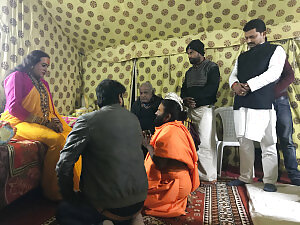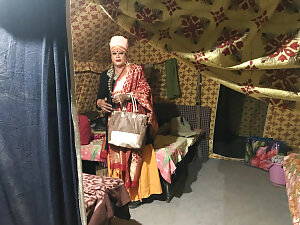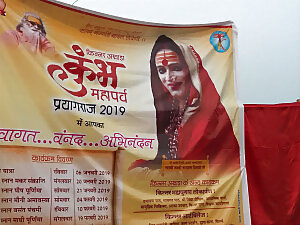
views
Prayagraj: Chants of Vedic hymns in Sanskrit echo near the Sangam—a point of confluence for Hindus – where a bath is believed to flush away all of one's sins. These voices emanating from the rows of tents sprawled across the banks of Ganga and Yamuna are manly. The priests who chant these hymns are men, all stationed across the sprawling area earmarked for the 2019 Kumbh Mela.
However, what sets one such cluster of tents apart is the voice behind the mantras. It’s rough and coarse as that of a man but those who are chanting these hymns aren’t men.
Unlike the Naga Sadhus—crowned with matted hair on ash smeared bare bodies—who walk nonchalantly naked, and thousands of Hindu priests who drape themselves in saffron clothing, people in this part of Kumbh Mela walk with an air of flamboyance and color. Their vibrant saris, shining jewellery, septum rings, make-up and the waist-length blond-streaked hair is in stark contrast from the other priests and worshippers.
This group of richly dressed Hindu saints like to be identified as ‘Kinnars’— neither men nor women. Ask one of them what the word means and they’ll say it is the name of “the oldest ethnic transgender community in the world with its own religious beliefs."
Earlier this week, Kinnars, also known as Hijras who can be Trans, intersex, or eunuchs, took their very first Devatva Yatra on the streets of Allahabad. They danced to the tune of Bhakti music. As several raths decorated with flowers carrying these Kinnars went through the city amid the noise of musical instruments and chanting of mantras, history was created.
For the first time, Kinnar saints of the Vedic Sanatan Dharma were given a space at the Kumbh Mela.
However, this community lacks recognition. The Akhil Bhartiya Akhara Parishad - an organisation of Hindu saints and ascetics in India, are yet to recognise them.
But for Kinnars, “nothing else will stop them anymore."The Long Struggle
As Laxmi Narayan Tripathai emerges out of a tent with a troupe of bodyguards, a group of impatient followers fall on Laxmi’s feet to seek her blessing. One of the man, perhaps, in his late fifties starts to cry.
“My son is battling brain tumor. Doctors are saying that he will die. Maayi, only you can save him," the man cries out.
Laxmi puts the man up on his feet, chants some mantras, blows air on his face and hands him a coin. In popular belief, a coin brings prosperity if given by a Kinnar. As the man starts to leave, Laxmi calls him back and announces: “I could even take you as my boyfriend."
The followers and other Kinnar priestesses who had gathered around Laxmi break into laughter, breaking the melancholic mood that had set in due to man’s helpless pleas.

“As a child, I was very confused. I was feminine and always wanted to dress in frocks. I liked the girls’ uniform," Laxmi said, sitting atop a makeshift throne that was neatly covered in colorful rugs and cushions.
Flanked by other Kinnars, who listened to her with undivided attention, Laxmi, draped in a yellow sari and thick sheets of gold and silver ornaments, initiated a tour through her life journey: days when she realized that she was a “woman trapped in a man’s body".
“When I started meeting members of the Hijra community, it dawned upon me that I was never supposed to be a man. The community taught me about wanting the best for each other and loving each other as a family," Laxmi proclaimed.
Soon Laxmi started to dance in the Mumbai bars to earn a living for herself. Later on, she would join the social sector in 1999, and work for a non-profit organization that was working for the rights of Hijras in India. The coming years would make Laxmi the first transgender South Asia representative in the United Nations and a petitioner in the Supreme Court case recognizing the ‘third gender’.
“That was a historical moment for LGBT community. We haven’t looked back since," Laxmi said.
As her efforts to legally recognize a third gender in India became successful in April 2014, Laxmi became the first Mahamandaleshwar Acharya (‘High Priestess’) of the Kinnar Akhada in 2016.
The Kinnars, first received recognition within the domain of religious practice when the Ujjain-based Akhada, namely the Akhil Bhartiya Sant Samiti invited the Kinnar Akhada for their annual meeting in New Delhi in November 2018. The male-dominated 13 Akhadas of saints have not yet accepted the Kinnars into their council.
“This establishment of the Kinnar Akhara," Laxmi said, “proved to be a stepping stone to regain the past glory of Hijras in India."
But according to Laxmi, the battle has just begun. The dismissal of accreditation from the Akhil Bhartiya Akhara Parishad is still a hurdle.
Yet, the people who have been thronging Kumbh are pouring immense love on the newly formed Kinnar Akhada. Daily thousands of people visit their camp seeking blessings, which according to Laxmi, is a manifestation that their mission to reclaim their religious identity is bound to succeed.
“We are present on earth from the time immemorial and are just reclaiming our lost space. First, it was within the society and now it is in our religion," Laxmi said.The Demigods
Hijras occupy a special place in Hinduism. In various Hindu scriptures, Hijras or Kinnars are seen as demi-gods who have historically played important roles in royal palaces as entrusted advisors.
However, during the British colonization of India, the rulers suppressed the fluidity of gender understanding and outlawed all such practices, where everything associated with Hijras was made illegal, forcing most of the community go underground.
But in 2014 when the Supreme Court acknowledged that “gender is a non-binary form of identity that goes beyond male and female", the Hijras like Laxmi wanted to incorporate the same status in religion as well.
But it wasn’t easy.

"I felt angry that my freedom of religion was being violated," Pavitra said, who is one of the priestesses at the Kinnar Akhada in Kumbh, a vast area which is literally the size of 3,200 football fields.
"We exist. We want nothing, nothing but our basic right to practice our religion," she added as she worked on her make-up before joining her followers who waited patiently outside her tent.
As Pavitra stepped out of her tent, many of the followers looked at her with a mix of awe and fascination. She explained that is isn’t a first.
In between answering phone calls, chatting with her mother and friends, Pavitra explained how Kinnars or Hijras are devotees of the Goddess Bahuchara Mata Hijras and find connection with a particular story of Arjun, the hero of the Mahabharata, when he disguised himself as a eunuch for one year.
“Arjun acted and lived in ways that modern Hijras do. This also provides textual legitimation to the lifestyle choices of us Hijras. But people still see us as aliens. I don’t know how much more we can explain to the people," Pavitra said.
In the social context of Hindu India, Hijras have an incredibly valuable power; one that is so deeply connected to ideas of good livelihood that people pay Hijras to bless their families.
Yet, in Kumbh, these members of the third gender community have stepped up for religious positions; their goal is to inspire a change within the community when it comes to rigid stances on religion.
“We are neither men nor women. We are the modern day avatars of demigods descended upon earth to bring visibility to a community that has long been marginalized," Pavitra proclaimed.
But not everyone in Kumbh is happy with their presence.
When the 21-year-old Gayatri (name changed) first entered the Kumbh on 6th of January, she says, “she became a new person."
“I was thrown out of the family by my parents when they came to know that I am a Hijra. My community accepted me as their own and helped me study and find a job," Gayatri, who works as a nurse in Aligarh, said.
Yet, her integration with the religious fold was something that changed her life.
“When I walked on the banks of Sangam I understood what it meant to a Hijra who is a Hindu. But the happiness didn’t last long as Sadhus starting mocking me," Gayatri said.
The discrimination first started with name calling. She was called a “Chakka"— a derogatory term fused or a Hijra in India. Then one of the Sadhus marched at her and tried to pull her by the hair.
“He started abusing me and said that people like me aren’t allowed to come to such a holy place," Gayatri said.
While the procession taken out by the Kinnar Akhada on last Sunday witnessed a resounding welcome by the locals, these cases of discrimination and hostility in last six days at the Kumbh have made the Kinnars wary about their safety.
Laxmi believes that “nobody will harm them at the Kumbh". They have made up their mind to face any kind of hostility during the 45-day period when millions of worshippers will throng the place.
One such person who is against the entry of Kinnars in the Kumbh is Shivanad Maharaj, a Sadhu who associates himself with the Shri Panchayti Akhara Mahanirvani, Allahabad.
According to him most of the Kinnars at Kumbh are born in Hindu families but had converted to Islam, and have suddenly started to throng the Kumbh Mela without even converting back to Hinduism.
“They are not welcome here. First, they need to take the Hindu fold and maybe then we can take a decision on whether they should be allowed to participate in the Kumbh or not," Shivanad said.
Other Sadhus have a more rigid stance.
Digambar Maharaj, who associates himself with the Shri Nirmal Panchayti Akhara, Haridwar said that “no impure soul should be allowed to station themselves on the banks of Sangam."
“They should be thrown out before the Shahi Snan," Digambar said, referring to the main ritual performed at that Kumbh Mela on the 15th of January.
But incidents and statements like these haven’t unnerved the likes of Laxmi, Pavitra and Gayatri.
For Laxmi, all this hostility isn’t unexpected. “We have come prepared. All these men just talk and do nothing. They were humiliated in 2014 and they will be humiliated again," she said. “We are the bad girls and we are here to stay."Walking a Tight Rope
The 2019 Kumbh Mela 2019—also the year of general elections—is being celebrated in the politically-effervescent state of Uttar Pradesh and the issue Ram Mandir issue might take centre stage during the Kumbh period.
The Vishwa Hindu Parishad (VHP) has announced that it will hold a Dharm Sansad in Prayagraj on January 31. On this day the sadhus will deliberate on their next course of action in view of the pendency of the matter in the Supreme Court around the construction of Ram Mandir.

Earlier in November 2018, Laxmi had voiced support for a Ram temple at the Babri Masjid site in Ayodhya. Soon after her comment, several LGBTQIA+ groups denounced her statement and claimed that she is “a dominant-caste Brahmin trans woman, has been appealing to Hindutva ideology and justifying the existence of the caste system in India ever since she began aspiring for a political position within the current ruling party."
But for Laxmi, the issue of Ram Mandir and the Kinnar Akhada are both matters of Hindu pride.
“Like everyone else, we also waiting for the Supreme Court's verdict. The temple should be built but I am against any violence in the name of Ram Mandir. Let the law of the land take its due course of action," Laxmi said.
As her followers waded through a crowd that had assembled outside her tent, Laxmi also hinted slyly to her political aspirations. “If the people of Allahabad want me to be their leader then I would like to be their leader. After all, we Kinnars need representation in the parliament as well," she said.“It’s Going to be One Heck of a Party."
Away from the political pitch that might be raised during the Kumbh, the Kinnars are also planning to create awareness during the 45-day long Mela. An art installation will feature the paintings and other artwork curated by them.
One of the curators of this installation, Puneet Reddy, will be showcasing his pictures once the Mela kicks in. Puneet has been following Laxmi and his troupe of followers from last two years when the Kinnar Akhada was established.
“Apart from the religion and their space in the religion, Kinnars also want to create awareness among the masses. I am glad that I am part of this campaign," Puneet said.
But the most excited about this art installation are the Kinnars themselves.
“Religion and awareness about a community will go hand in hand this time. We will worship our gods, raise awareness among people and at the same time live our life to the fullest. It’s going to be one heck of a party," Riya, a Kinnar who has come from Bangalore, said in fluent English.
As the evening started to flourish over Sangam and final rituals for the day were completed, Riya asked one of her companions to answer a question.
"After the end of the Kumbh, what is it that you want to take back home from the one and a half month stay here?" she asked.
Shruti, her friend, who was staying next to a bonfire exclaimed: "You aren’t talking about the bare bodied Sadhus?"
Riya laughed and shook her head left and right.
“Then, perhaps, I would like some self-courage to face the world which discriminates us on the basis of gender and choice of religious freedom," Shruti answered back, adding, “and If I find someone to love me that would do as well."
Clearly pleased, Riya smiled broadly.




















Comments
0 comment